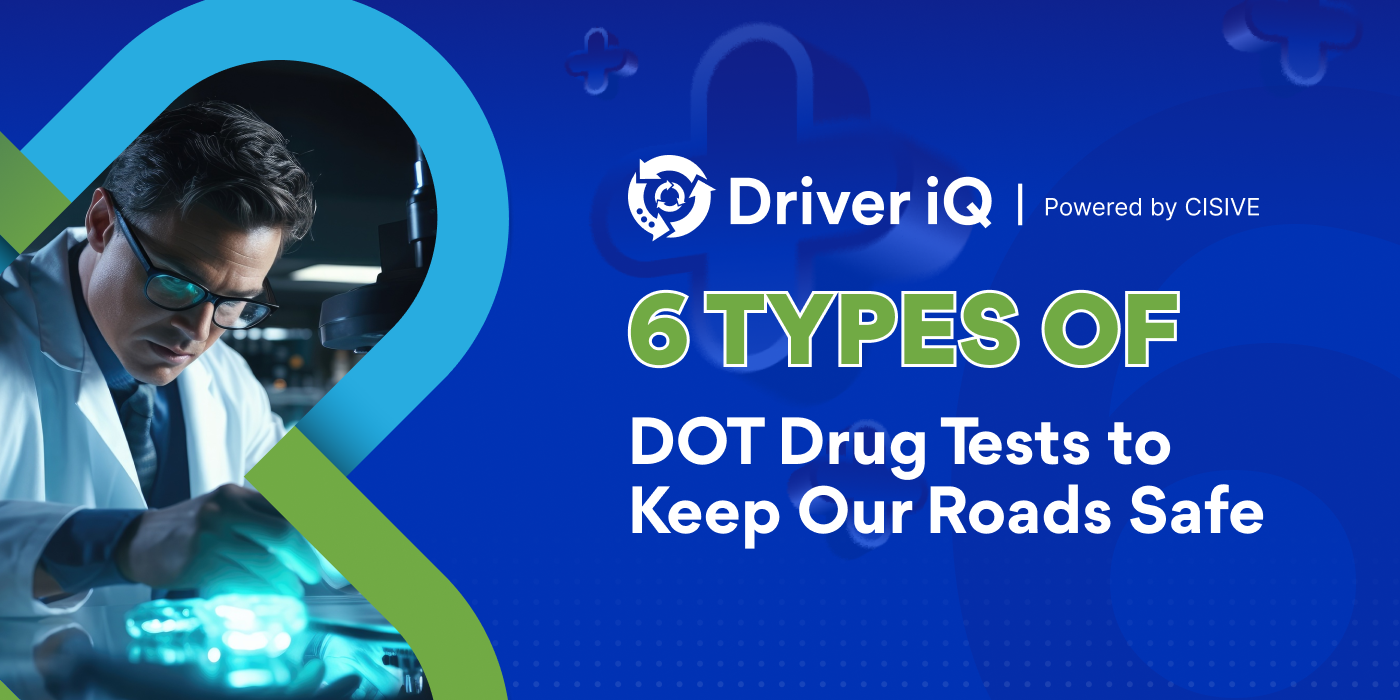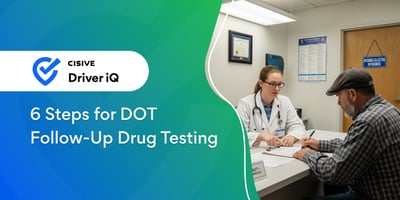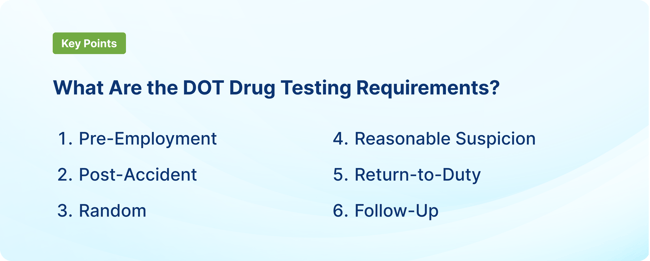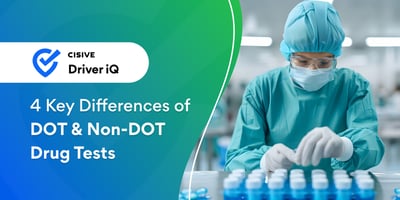

When drivers fail a DOT-mandated drug or alcohol test or refuse to take one, they create...

If you employ commercial drivers, your company is responsible for maintaining a formal drug testing program. The CDL drug test requirements are designed to reduce the risk of crashes involving drug and alcohol use. Here's what you need to know about CDL drug testing:
If your company employs CDL drivers, it's critical to comply with the federal CDL drug test requirements. Drug testing keeps the roads safer, preserves your company's reputation, and reduces the risk of fines and other penalties.
The requirements are somewhat complex, so it's easy to misunderstand them. To prevent operational disruptions, partner with an experienced employment screening company.
Key Takeaways
|
The U.S. Department of Transportation exists to promote safe, efficient transportation. As part of its mission, the federal agency requires employers to perform drug tests on commercial drivers.
Your CDL drug test program must comply with the regulations outlined in Title 49 of the Code of Federal Regulations. These are some of the most common DOT drug testing violations:

Title 49 outlines the procedures you must follow when testing employees in safety-sensitive positions. For example, employers must perform drug tests at certain intervals.
You're also required to conduct a yearly DOT Clearinghouse search for every driver you employ. The DOT Drug & Alcohol Clearinghouse has a record of drug and alcohol violations committed by commercial drivers.
Checking the Clearinghouse makes it possible to uncover past violations even if an employee doesn't disclose them. Therefore, it may help you avoid using drivers who are likely to drink or use drugs on the job.
Recommended Reading: Cisive Product Highlight: Drug Screening & Occupational Health
Preemployment drug tests are one of the most important components of a DOT testing program. To comply with the requirements, you must conduct a CDL drug test and wait for the results before allowing an employee to drive a commercial vehicle.
One of the major advantages of conducting preemployment drug tests is that you have an opportunity to prevent future DOT violations. If a prospective employee fails the required test, you can rescind your offer and move on to the next candidate.
Requiring preemployment drug tests also contributes to a safer work environment. If you comply with the testing requirements and take swift action when a violation occurs, other employees will know that your company is serious about safety.
In most cases, you must also conduct a CDL drug test after an accident. DOT requires post-accident testing in these circumstances:
You don't have to conduct a post-accident test in these situations:
Simply put, you must conduct a CDL drug test after any accident resulting in a fatality. You must also conduct this type of test if one of your drivers receives a citation due to an accident involving bodily injury or disabling damage to a vehicle.
Post-accident testing makes it possible to identify employees who are engaging in risky behaviors. If they test positive, you can remove the employee from duty and refer them for alcohol and drug treatment.
Complying with the post-accident testing requirements also helps preserve your company's reputation. Community members need to know that you're doing everything possible to protect them from unsafe drivers.
Under the DOT regulations, you're also required to maintain a random drug testing program. This type of testing is different from other CDL drug test requirements because it requires a random selection of employees.
Employers typically use random number generators to select employees. This makes it easier to ensure the testing is truly random.
If you're subject to the DOT testing regulations, you must conduct random tests throughout the year. You can't conduct all tests in the first quarter and then do no testing for quarters two, three, and four.
You must also test a certain percentage of your average positions each year. The required testing rates vary by DOT agency.
For example, if you have an average of 200 drivers per year and you're subject to the FMCSA requirements, you must conduct random drug tests for at least 50% of those drivers. In other words, you'd have to conduct 100 or more random drug tests per year to stay in compliance.
The major benefit of random testing is that it lets you identify drug and alcohol problems before they result in accidents. Conducting random drug and alcohol tests may even help you preserve your company's reputation.
If you have a reasonable suspicion that a driver may be under the influence of drugs or alcohol at work, you must also conduct reasonable suspicion testing. Note that you may only conduct this type of testing if a supervisor has direct knowledge of an employee's behavior.
For example, if a supervisor notices that a driver has slurred speech and smells of beer, it's appropriate to require testing based on these observations. You can't require a drug or alcohol test based on information from a third party.
Like random testing, reasonable suspicion testing lets you identify potential safety hazards before they lead to an accident. If you receive a positive result, you can refer the employee for drug/alcohol counseling and take additional steps to protect the community from harm.
If one of your employees completes a drug and alcohol treatment program, you must conduct a return-to-duty drug test before allowing them to return to their safety-sensitive duties. Return-to-duty drug testing is also required after an employee refuses to complete a random drug test or a reasonable suspicion drug test.
The return-to-duty process includes these steps:
Return-to-duty testing keeps impaired employees off the road, making the community safer. It may also help your company avoid negative press and save money on legal costs.
This type of drug testing also gives employees a chance to address their substance abuse problems. Successful completion of treatment may help these employees improve their physical and mental health.
Follow-up drug testing ensures an employee doesn't continue to use drugs or alcohol after completing substance abuse treatment. A substance abuse professional determines an appropriate testing plan based on the employee's unique needs.
Under the DOT guidelines, you must conduct at least six follow-up tests within 12 months of the employee's return to duty. You can always conduct additional tests if you're concerned about the potential for relapse.
Depending on the extent of the employee's substance use disorder, you may have to conduct additional follow-up tests for up to 48 months (4 years) after the initial 12-month period. Once you complete the recommended testing plan, you must submit proof of completion to the DOT Clearinghouse.
The main benefit of follow-up testing is that it lets you monitor an employee's progress following a return to duty. If an employee tests positive for drugs or alcohol, you have an opportunity to refer them for treatment and protect your company from the risks associated with having an impaired driver behind the wheel.
Recommended Reading: Understanding DOT's Preemployment Drug Testing Requirements
Certified laboratories use specific cutoff levels to determine if a test is presumptive positive or negative. Each type of test has a different cutoff level to ensure accuracy.
The initial test is the first drug or alcohol test completed. It could be a random test, a return-to-duty test, or a post-accident test.
If an initial test produces a presumptive positive result, the lab conducts confirmatory testing. The cutoff for confirmatory testing is typically lower than the cutoff for initial testing, with exceptions for codeine/morphine, oxycodone/oxymorphone, and phencyclidine.
The table below shows the initial and confirmatory cutoffs for each substance tested.
.png?width=600&height=633&name=Blog%20Chart%20(DOT%20Drug%20Testing%20Requirements).png)
Recommended Reading: Streamline Onboarding with a Fully Integrated Drug Screening Process
Complying with the DOT CDL drug test requirements is one of the best ways to prevent accidents and preserve your company's reputation. If you're required to follow the DOT guidelines, you must conduct random tests, post-accident tests, reasonable suspicion tests, and return-to-duty tests.
To improve compliance, partner with a trusted employment screening provider. A reputable company can handle your entire testing process, giving you more time to focus on operations.
Driver iQ offers comprehensive screening solutions for employers in highly regulated industries. We have extensive experience conducting background checks and helping transportation companies comply with the DOT testing requirements.
Partnering with Driver iQ takes the guesswork out of DOT testing and makes it easier to comply with federal regulations. Speak with an expert to schedule a demo.
Author: Jessica McDonald
Bio: Product Strategy and Development, Drug Testing and Occupational Health Subject Matter Expert at Cisive
Let's Connect on LinkedIn
When drivers fail a DOT-mandated drug or alcohol test or refuse to take one, they create...

No matter how many employees you have, you're responsible for keeping them safe. Employers also...
%20-%20Blog%20Post-1.png?height=200&name=BLOG_%20Understanding%20DOT%E2%80%99s%20Preemployment%20Drug%20Testing%20Requirements%20(Refreshed)%20-%20Blog%20Post-1.png)
The Department of Transportation (DOT) has hundreds of regulations designed to keep motorists,...